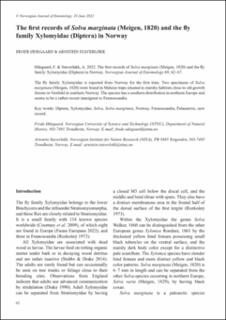| dc.description.abstract | The fly family Xylomyidae belongs to the lower Brachycera and the infraorder Stratiomyiomorpha, and these flies are closely related to Stratiomyidae. It is a small family with 134 known species worldwide (Courtney et al. 2009), of which eight are found in Europe (Fauna Europaea 2022), and three in Fennoscandia (Rozkošný 1973). All Xylomyidae are associated with dead wood as larvae. The larvae feed on rotting organic matter under bark or in decaying wood detritus and are rather inactive (Stubbs & Drake 2014). The adults are rarely found but can occasionally be seen on tree trunks or foliage close to their breeding sites. Observations from England indicate that adults use advanced communication by stridulation (Drake 1990). Adult Xylomyidae can be separated from Stratiomyidae by having a closed M3 cell below the discal cell, and the middle and hind tibiae with spurs. They also have a distinct membranous area in the frontal half of the dorsal surface of the first tergite (Rozkošný 1973). Within the Xylomyidae the genus Solva Walker, 1860 can be distinguished from the other European genus Xylomya Rondani, 1861 by the thickened yellow hind femura possessing small black tubercles on the ventral surface, and the mainly dark body color except for a distinctive pale scutellum. The Xylomya species have slender hind femura and more distinct yellow and black color patterns. Solva marginata (Meigen, 1820) is 6–7 mm in length and can be separated from the other Solva-species occurring in northern Europe, Solva varia (Meigen, 1829), by having black coxae. Solva marginata is a palearctic speciesdistributed in Central and Southern Europe including Turkey. In northern Europe the species is recorded from England, The Netherlands, Germany, Denmark, Finland, Sweden, and Estonia (Global Biodiversity Information Facility 2022). The species might utilize different species of deciduous trees as hosts, but seems to prefer elm Ulmus glabra, and aspen Populus tremula in Fennoscandia (Struwe 2008). Elsewhere in Europe it is also found on Salix-species and Norway maple Acer plantanoides (Aleksander 2002). The larvae develop in stems of recently dead, large trees of more than 50 cm in diameter for aspen and elm (Struwe 2008). Diptera, Xylomyidae, Solva, Solva marginata, Norway, Fennoscandia, Palaearctic, new record. | en_US |
